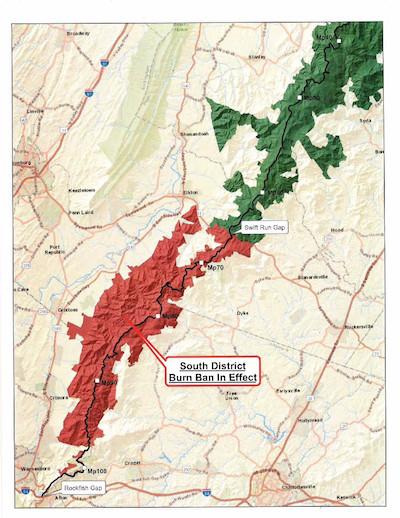
Though there are no forest fires inside Cumberland Gap National Historical Park that touches parts of Kentucky, Tennessee, and Virginia, fires in the vicinity have sent smoke into the park/Harold Jerrell
With wildfires burning in many places of the Southeast, and extremely warm and dry conditions in the forests, Great Smoky Mountains National Park has banned all campfires and use of fire grills in the park, while to the north in Shenandoah National Park fire restrictions have been put in place in the South District.
In the Smokies in Tennessee and North Carolina, officials say that "due to continued dry conditions and widespread wildfires throughout the region, (they) have issued the parkwide ban to further reduce the risk of escaped fires. The fire restriction will be in effect until further notice."
"The fire ban applies to the use of all campfires and grills throughout the park, including frontcountry and backcountry campsites and picnic areas," they added. "No use of wood or charcoal fires is permitted. In addition, park visitors are reminded to extinguish all cigarettes, cigars, and pipes and dispose of them in appropriate containers. At this time, campers may continue to use gas camp stoves at designated campsites throughout the park."
“We are taking these extra precautions to help reduce the threat of wildfires and provide for visitor safety throughout the park,” said Chief Ranger Steve Kloster. “We ask that everyone respect this ban and report any signs of fire throughout the park.”
Backpackers should be aware that these dry conditions affect the availability of water at springs at backcountry campsites and shelters throughout the park. At some locations where there is a running spring, it can take more than five minutes to fill a quart-sized bottle. The following backcountry campsites are currently known to be without water: 5, 6, 14, 16, 19, 26, 113, Mollies Ridge Shelter, Russell Field Shelter, Spence Field Shelter, Silers Bald Shelter, Double Spring Gap Shelter, and Pecks Corner Shelter. Other campsites may be without water as the drought conditions continue. Backpackers are encouraged to carefully consider their itinerary and carry extra water for those sites that are not located along major water sources.

Fire restrictions are in place in the South District of Shenandoah National Park/NPS
In Virginia at Shenandoah, park officials Wednesday morning issued a range of fire restrictions for the South District of the park between Highway 33 in the north and Highway 64 in the south. Due to exceptionally dry conditions in this area of the park and the potential for extreme fire behavior, the restrictions listed below will be in effect until the south end of the park receives sufficient precipitation.
- Building, attending, maintaining or using an open fire anywhere within the South District of Shenandoah National Park is prohibited. This ban includes:
- All wood, charcoal, coal or other solid fuel open air fires.
- Fires in grates, grills, rings or pits in campgrounds, picnic areas, shelters and huts.
- Please note that wood, charcoal, coal or other solid fuel fires are always prohibited in the backcountry of the entire Shenandoah National Park.
- The use of pressurized gas-fuel camp stoves and backpacking stoves will be allowed in Dundo Picnic Grounds and in the backcountry. However, the use of liquid-fuel or wood-fuel portable stoves is prohibited.
- Smoking will be permitted only inside vehicles and at established paved or gravel parking areas. Smoking will be prohibited on all trails.
These restrictions will better provide for public safety, Shenandoah officials said. The south end of the park and surrounding lands are significantly dry and the potential for wildland fires is high.
The fire restrictions will remain in effect until conditions improve with significant rain or snow over time, decreasing the fire hazard, officials said.



Add comment